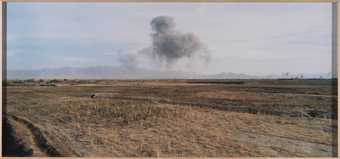This five-week course invites you to critically engage with the different ways artists have addressed issues around war and conflict exploring how violence becomes visible over time. The sessions raise questions such as: How do artists interrogate the representation of violence? What is the place of art in the realm of war? What are the aesthetics of conflict? How do artists deal with the relationship between form and content when dealing with political subject matter?
The course centers around discussions, group activities and visits to the Conflict, Time, Photography exhibition and the collection displays at Tate Modern out of hours. For anyone interested in the relationship between art and politics, no prior knowledge required. Ticket price includes drinks following the course sessions.
Dr Ele Carpenter is a curator, writer (and sometimes artist) in politicised art and interdisciplinary social networks of making. Her Nuclear Culture curatorial research project is a partnership between The Arts Catalyst and Goldsmiths College, University of London, where she is a Senior Lecturer in MFA Curating. The Nuclear Culture research focuses on nuclear aesthetics from the atomic sublime to radioactive divinity; the relationship between social and material concerns in the nuclear cycle; and how the nuclear effects our perception of deep time within the Anthropocene. She recently curated the Actinium exhibition, forum and field trips to nuclear sites in Japan 2014; and is curating an exhibition on Perpetual Uncertainty for the Bildmuseet, Sweden, 2016.
Schedule
Week 1: Monday 10 November: Tate Modern
This introductory week starts in Transformed Visions with a discussion of visibility and exposure in works by Omar Fast, Leon Golub, and Hrair Sarkissian. We will also discuss the course reading material by writers such as Jaques Derrida, Ian Waites, Liam Sprod, Peter Hayes, Sigmund Freud, Rob Nixon, and Isabelle Stengers.
Week 2: Monday 17 November: Tate Modern
Taking place in Poetry and Dream and Energy and Process displays we will focus on key concepts raised in the course reading materials. Working in groups, we will interrogate the relationship between form and content of the artwork to rethink questions of materiality, time and agency.
Week 3: Monday 24 November: Tate Britain
Taking place at Tate Britain, we will examine questions of nuclear materiality through works by Henry Moore, Peter Kennard, and Colin Self. We will also examine the structural violence of the land enclosures within British landscape painting.
Week 4: Monday 1 December: Tate Modern
Exploring the Conflict, Time, Photography exhibition, we will investigate ideas such as the atomic sublime and the radioactive uncanny.
Week 5: Monday 8 December: Tate Modern
This last session will include group presentations on key works in the Conflict, Time, Photography exhibition, drawing from the ideas discussed throughout the course.

